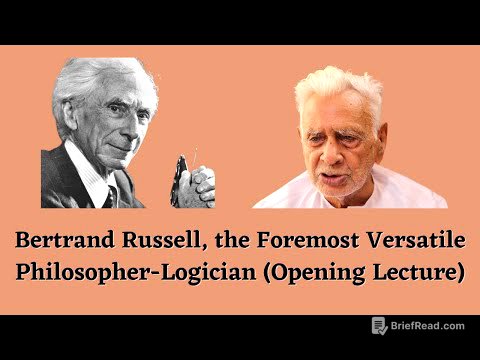TLDR;
This lecture provides a comprehensive overview of Alfred Wegener's Continental Drift Theory, starting from its basic concepts to its implications for the UPSC exam. It explains how Wegener challenged the prevailing belief of static continents by proposing that continents were once joined in a supercontinent called Pangaea, which later broke apart. The lecture covers the evidence supporting the theory, including the jigsaw fit of continents, fossil evidence, rock formations, glacial deposits, and coal deposits. It also discusses the limitations and criticisms of Wegener's theory, particularly his inability to explain the mechanism behind continental drift.
- Introduction to Continental Drift Theory and Alfred Wegener
- Evidences Supporting Continental Drift Theory
- Limitations and Criticisms of Wegener's Theory
Introduction: The Paradigm Shift of Continental Drift Theory [0:01]
Before Alfred Wegener introduced his Continental Drift Theory in 1912, the prevailing belief was that the Earth's continents had always been in their current positions. Wegener challenged this idea, asserting that the continents were once part of a supercontinent called Pangaea. Over time, Pangaea broke apart, and the resulting continents drifted to their present locations. Wegener's theory revolutionized the understanding of geography and paved the way for future developments in plate tectonics.
The Supercontinent Pangaea and Panthalassa [5:35]
Wegener proposed that all the continents were once joined together in a supercontinent called Pangaea, surrounded by a super ocean named Panthalassa. Around 200 million years ago, during the Jurassic period, Pangaea began to break apart into two major landmasses: Laurasia in the north and Gondwana in the south. These landmasses further fragmented, eventually forming the continents we know today.
Evidences Supporting Continental Drift: Jigsaw Fit and Fossil Records [10:46]
Wegener supported his theory with several lines of evidence. The first was the jigsaw fit of the continents, noting how the shapes of continents like South America and Africa appeared to fit together like puzzle pieces. He also cited fossil evidence, such as the Glossopteris fern and the Mesosaurus reptile, whose remains were found on multiple continents separated by vast oceans. This distribution suggested that these landmasses were once connected.
Geological Evidence: Rock Formations and Glacial Deposits [17:26]
Further evidence for continental drift came from geological similarities between continents. Wegener pointed to matching rock formations and mountain ranges found on opposite sides of the Atlantic Ocean, such as the Hercynian folds and Caledonian mountain ranges in the eastern United States and western Europe. He also noted the presence of glacial striations and deposits (tillites) in regions like South America, Africa, India, and Australia, indicating that these areas were once located closer to the South Pole and experienced glaciation.
Climatic Evidence: Coal Deposits in Temperate Regions [21:33]
Wegener also used climatic evidence to support his theory. He observed that coal deposits were found in temperate regions of North America, Europe, and Eurasia. Coal formation requires abundant vegetation, which is more common in tropical climates. This suggested that these regions were once located closer to the equator and later drifted to their present latitudes.
Limitations and Criticisms: The Unexplained Mechanism of Drift
Despite the compelling evidence, Wegener's theory faced significant criticism, primarily because he could not explain the mechanism behind continental drift. He incorrectly attributed the movement of continents to tidal forces and the Earth's rotation, which were insufficient to move such large landmasses. Additionally, Wegener's idea that continents (sial) were drifting on top of oceanic crust (sima) was later proven wrong by the theory of plate tectonics.
UPSC Mains Question: Merits and Demerits of Continental Drift Theory [24:24]
The lecture discusses a potential UPSC Mains question: "Examine the Merits and Demerits of Alfred Wegener's Continental Drift Theory." The answer should include an introduction explaining the pre-Wegener idea of permanency and how Wegener's theory challenged it. The merits section should highlight the scientific explanation provided by Wegener's evidence. The demerits section should address the limitations, such as the lack of a mechanism for drift, wrong conceptions about the forces involved, and the incorrect idea of continents floating on oceanic crust.
Demerits Explained: No Mechanism, Wrong Forces, and Incorrect Crustal Structure [29:26]
The demerits of Wegener's theory include his failure to explain the mechanism of continental drift, his wrong conception of the forces involved (tidal and centrifugal forces), and his incorrect understanding of Earth's crustal structure. Wegener proposed that the continental crust (sial) was floating on the oceanic crust (sima), which is not accurate. The plate tectonics theory later revealed that the lithosphere, composed of both continental and oceanic crust, floats on the asthenosphere.
Further Demerits: Mountain Formation and Direction of Drift [32:21]
Additional demerits of Wegener's theory include his inability to correctly explain the formation of mountains and islands. He suggested that mountains were formed by wrinkles due to friction as continents drifted, which is an oversimplified explanation. Wegener also proposed that continental drift occurred only in specific directions (north or east), while the plate tectonics theory shows that lithospheric plates can move in all directions.
Conclusion: Wegener's Enduring Legacy [34:54]
Despite its limitations, Wegener's Continental Drift Theory was a groundbreaking idea that was way ahead of its time. It laid the foundation for the development of plate tectonics theory, which provided a more complete and accurate explanation of Earth's dynamic processes. Wegener's work remains a significant contribution to the field of geology and continues to inspire scientific inquiry.
Assignment and Connecting with the UPSC Community [37:36]
The lecture concludes with assignments for the viewers, including writing an answer to the first question in the comment section, listing the evidences and creating a mnemonic to remember them, and considering the challenges or demerits of Wegener's theory. Viewers are encouraged to share the initiative with the UPSC community and connect on social media for more content and discussions.







![[사나의 냉터뷰] 사나 언니 홀리러 온 아기 고양이 닝닝🐈⬛l EP.11 에스파 닝닝 편](https://wm-img.halpindev.com/p-briefread_c-10_b-10/urlb/aHR0cDovL2ltZy55b3V0dWJlLmNvbS92aS9NWjZyUjVYUm1XZy9ocWRlZmF1bHQuanBn.jpg)

